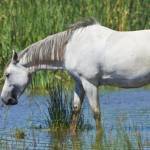West Nile Virus and Mare Reproductive Loss Syndrome

West Nile virus was first reported in the northeast United States in 1999. Since then, cases have been reported in almost every state and several Canadian provinces. Spread by mosquitoes, the virus can infect humans, horses, donkeys, mules, birds, and a host of other animals ranging from bears to alligators. Many infected horses are asymptomatic or show only slight fever or listlessness for a few days. In a small percentage of horses, the virus causes inflammation of the brain and spinal cord leading to stumbling, weakness, incoordination, and muscle twitching in addition to fever and loss of appetite. Some horses become jumpy, unwilling to be handled, and even aggressive. Among those diagnosed with encephalitis, about 1/3 die or are euthanized. Most surviving horses make a full recovery, though the process may take a year or more.
Commercially available vaccines have been shown to be very effective for the prevention of West Nile virus infections and vaccinated horses have increased chances of surviving infection if they develop clinical signs. Semi-annual boosters may be given in areas where mosquito populations are high year-around.
A study at Colorado State University showed that the vaccine is very effective in protecting horses that complete the initial series at least 30 days before the start of mosquito season. Horses that have had only one dose or have developed signs of disease before being vaccinated have only partial protection. Contrary to some reports, the West Nile vaccine has not been linked to abortions, deformities in foals, or other reproductive or health problems in horses.
Other relevant facts include:
- Horses can’t pass the disease to humans or to other horses. The only route of infection is through the bite of an infected mosquito.
- The most commonly used test for West Nile virus infection is the IgM capture ELISA, which detects antibodies made in response to acute infection. The test is able to differentiate antibodies produced from vaccination and those from actual infection.
- The USDA’s Agricultural Research Service has found a baculovirus that kills only mosquitoes. The virus could theoretically be developed into a spray that would help eliminate populations of the insects.
- Besides vaccinating horses, measures to prevent disease include eliminating standing water near horse operations; keeping horses in during periods when mosquitoes are active; installing screens and fans in barns; and using an insect repellent that is designed to be effective against mosquitoes.
Dimished threat, but few answers for Mare Reproductive Loss Syndrome
Foaling season in Kentucky in 2001 was hit by disastrous losses of newborn foals and many abortions in newly pregnant mares. The spring of 2002 saw a somewhat less widespread but still serious problem as scientists and veterinarians scrambled to find answers. Breeders were on edge very early in 2003 when the first weeks of January saw higher abortion numbers than in any previous year. However, except for this peak that may not have been related to MRLS, foaling and rebreeding appeared to have returned to normal.
Research into possible causes of MRLS began almost as soon as the problem was recognized in 2001. Many factors—endotoxins from pasture fungus or mold, chemicals in weather-stressed grass, bacterial or viral infections, fescue toxicity, poisonous plants—were investigated and ruled out as primary culprits in the foal deaths and early-term abortions. Scientists were left to focus on what had been considered merely an unusual spring event: an extremely heavy hatch of Eastern tent caterpillars.
By mid-spring of 2002, studies proved there was a definite relationship between reproductive problems and the caterpillars, but the exact toxin was difficult to isolate. Management was aimed at ways to limit contact between pregnant mares and caterpillars. Thousands of wild cherry trees, whose cyanide-laden leaves are a primary caterpillar food, were removed from Bluegrass fence lines. Remaining trees were pruned or sprayed to reduce insect populations, and work was accelerated on a tree bark inoculant that would repel the caterpillars. MRLS-related losses were numerous in 2002, but not as high as the previous year.
Research has eliminated caterpillar entrails and droppings as problem-causing elements. The most commonly accepted theory is that setae (small hairson the caterpillar) act as small needles in the gut and allow bacteria to enter the blood stream. The seeding of the mare’s blood with bacteria can result in abortion, eye infections, or fluid in the pericardial sac. Other investigations are looking at Eastern tent caterpillars from states other than Kentucky and at Western tent caterpillars from Washington in hopes of finding clues that will increase the base of knowledge. The healthy foals and minimal problems of 2003 may have led horsemen to hope the syndrome has gone away, but the investigation is far from over.








